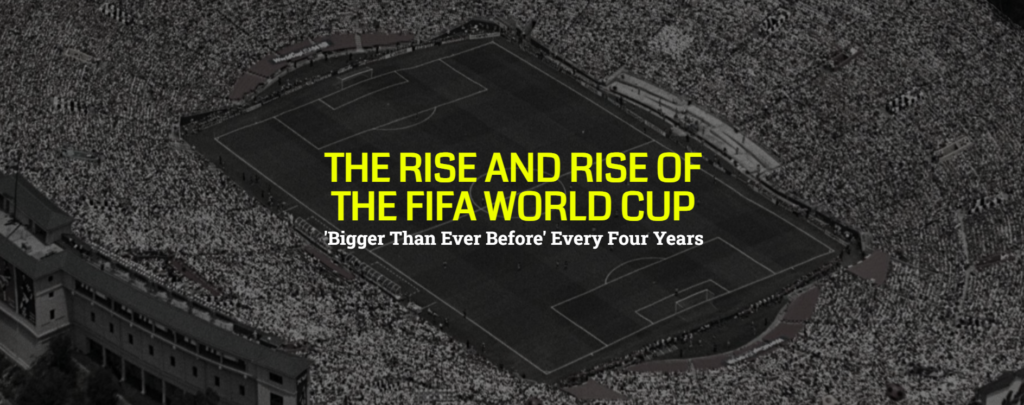Our attention span is decreasing, moving closer to that of a goldfish. Honestly, the gold fish might just win here. In this fast paced world it is very important for a marketeer to be precise and concise about selling products. The future is data-driven, which can help us hold readers’ attention longer.
I recently found a story from The Quint titled “FIFA World Cup Qatar 2022: Astonishing Stories, History, Stats & Graphics.” I love how this data-driven piece uses compelling visuals to make complex statistics accessible to a wide audience. The graphics enhance storytelling and illustrate key historical trends and remarkable FIFA World Cup facts. This engaging format keeps readers interested while providing valuable insights into the event. You can view the article here
An interesting fact about this story is that, upon opening it, an interactive pop-up appears. This pop-up highlights that the story is free but took 4 days, 15 hours, and 7 minutes of work, tech, and resources to produce. Clicking on ‘support our work’ will open another page that takes you to buy a subscription.

The article speaks volumes of not just storytelling, but data-driven story telling. The Quint claims the story to be multimedia immersive, which is however true.
After closing the pop-up, the first visual shows a football match from a recent FIFA World Cup. If you click the volume icon in the top right, you can hear cheering in the background.

As a football fan, this story kept me engaged for hours with its fun facts and captivating visuals. The color scheme used by the production team is highly at par. The title itself grabs attention because it appears in the middle of a crowded football field, and the cheering sounds immerse the reader in the moment.

Scrolling further, you’ll find a slider comparing the 1930 WC Final to the 2018 WC Final, almost a century apart. This slider reminds readers that in 1930, attending the game at the stadium was the only way for fans to watch. In 2018, FIFA reported that 3.57 billion viewers—more than half the global population aged four and older—tuned in to watch the World Cup.

The slider shows us the stadium at the WC Final 1930 and WC Final 2018.
The FIFA WC hosted by the United States in 1994 witnessed more than 3.56 million people at the stadium. This is a record for the highest turnout at an edition of the World Cup. The story includes an interactive chart showing the average turnout per match for each World Cup edition.
Further down the story, there are two unfortunate events that prevented India and Austria from participating in the FIFA WC. These are impeccably explained using scroll-through bar graphs.


Definitely, the World Cup comes with a prize! The Quint story highlights adventures of the treasured trophy, which was hidden in a shoebox, and another trophy found by a dog. Winners of the football World Cups between 1930 and 1970 received the Victory trophy. This trophy was made out of gold-plated sterling and depicted Nike, the Greek goddess of victory. At the start of World War II, Italy, the 1938 champion, held the trophy. Ottorino Barassi, the president of the Italian Football Association, discreetly removed the trophy from a bank safe and hid it in a shoebox under his bed, fearing that Mussolini and his Nazi allies might seize it.
Just before the 1966 FIFA World Cup in England, the Jules Rimet trophy (formerly the Victory trophy) was stolen during a public display in London. Amazingly, it was discovered only a week later under a car by a dog named Pickles! Thanks to Pickles’ discovery, the England team lifted the original Jules Rimet trophy after winning the World Cup on home turf later that year. Now that’s a true World Cup hero!

The heartwarming story of the Chatterjee’s from India, who attended every World Cup starting from 1982 Spain to 2018 Russia.

Crack, Tango, Challenge, and Fevernova are all names of official FIFA World Cup footballs from different tournaments. Every World Cup is celebrated in a distinct way, reflecting the culture and symbols of its host nation. Each edition showcases the tournament’s diversity and global appeal through unique mascots, posters, logos, and footballs.
The story features the official poster from every FIFA World Cup, dating back to the very first edition. As you scroll further, you can also find the World Cup logos, which can be filtered by year. My favorite is the 2010 South Africa World Cup, as I have fond memories of watching the games with my loved ones.

As you scroll further, the official ball of each World Cup since 1930 is displayed. Progressively, The champions of yesteryears, the teams that have lifted world football’s most coveted prize are available through the scroll-feature.
As a closing fact to the FIFA WC, here’s one about this immersive multimedia story on The Quint. This story is a tribute to the late Sumit Josh, who covered the 2018 FIFA World Cup for The Quint.








